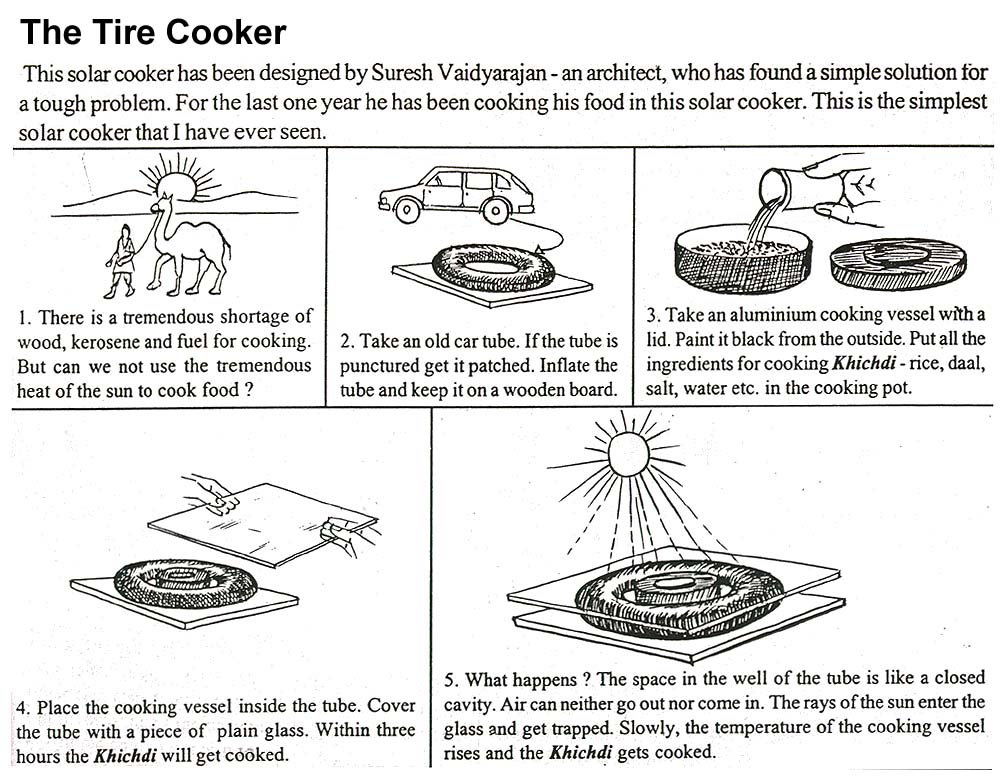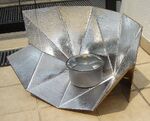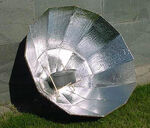Selected designs
Panel-style cookers
| Advantages | Disadvantages | |
| General characteristics |
|
|
|
| |
| Windshield Shade |
|
|
| Cookit |
|
|
| Sunny Cooker |
|
|
See all Panel cooker plans.
Box-style cookers
| Advantages | Disadvantages | |
| General characteristics |
|
|
| The "Minimum" |
|
|
| Easy Lid |
|
|
| Heaven's Flame |
|
|
See all Box cooker plans.
Parabolic cookers
| Advantages | Disadvantages | |
| General characteristics |
|
|
| DATS |
|
|
Windshield Shade Solar Funnel Cooker
While experimenting with various designs of cookers over the past year to introduce in the indigenous communities where I live and work in southern Mexico, I hit upon an utterly simple way to make an instant portable solar oven. Taking a reflective accordion-folded car windshield shade, you can turn it into a version of the solar funnel, by simply sewing on little Velcro tabs along the long notched side. Here’s how:
 | Materials needed:
|
 Lay the sunshade out with the notched side toward you, as above.
Lay the sunshade out with the notched side toward you, as above.- Cut the Velcro into three pieces, each about 4 cm. or 1 ½ inches long.
- Hand sew one half of each piece, evenly spaced, onto the edge to the left of the notch; sew the matching half of each piece onto the underneath size to the right of the notch, so that they fit together when the two sides are brought together to form a funnel. (see below) Note: I first tried sewing these on a sewing machine, but found it cut through the reflective material.
- Press the Velcro pieces together, and set the funnel on top of a bucket or a round or rectangular plastic wastebasket.
- Place a black pot on top of a square cake rack, placed inside a plastic baking bag. A standard size rack in the U.S. is 25 cm. (10 in.). This is placed inside the funnel, so that the rack rests on the top edges of the bucket or wastebasket. Since the sunshade material is soft and flexible, the rack is necessary to support the pot. It also allows the suns rays to shine down under the pot and reflect on all sides. If such a rack is not available, a wire frame could be made to work as well. Note: the flexible material will squash down around the sides of the rack.
 The funnel can be tilted in the direction of the sun.
The funnel can be tilted in the direction of the sun.
A stick placed across from one side of the funnel to the other helps to stabilize it in windy weather. (see below)
After cooking, simply fold up your “oven” and slip the elastic bands in place for easy travel or storage.
I have found this totally simple solar oven extremely practical, as it is so lightweight and easy to carry along anywhere. But in addition, it has reached a higher temperature in a shorter time than all the other models I have experimented with so far (I haven’t used a parabolic) - a little above 350 degrees F. I have cooked black beans in about the same amount of time as on a gas stove; I’ve used it to bake breads, granola, brownies, lasagna, all sorts of vegetables, and to purify water. The sunshade may not be available everywhere, but I suspect it can be found in most urban areas, since I found it here in southern Mexico. The Velcro was also available in fabric stores. Cost of the sunshade was about $3.00 USD; the Velcro about $.25











No comments:
Post a Comment